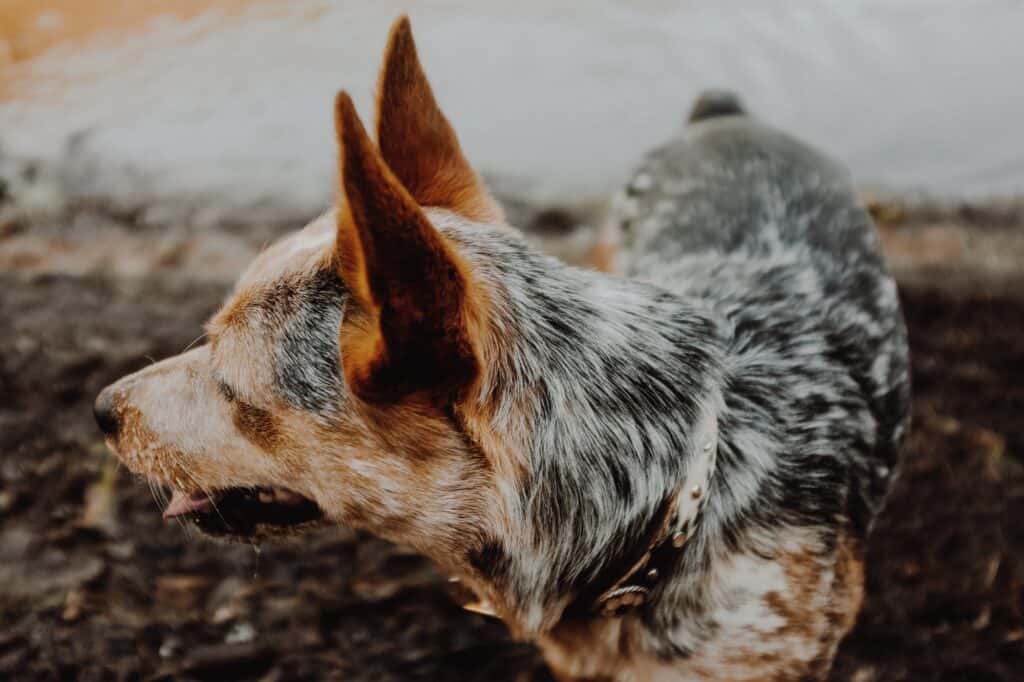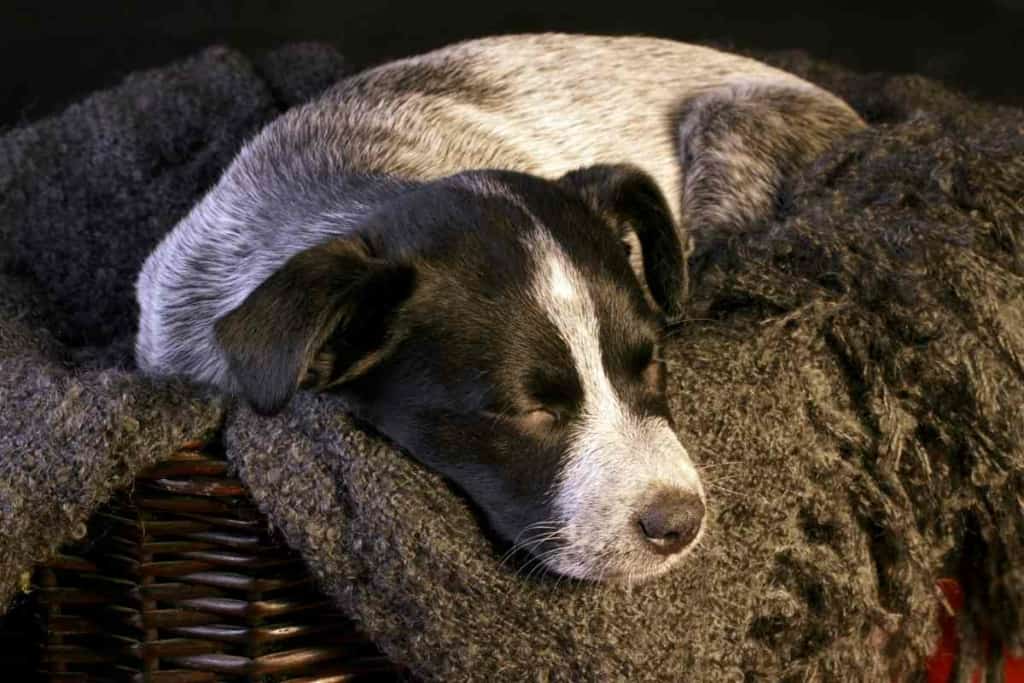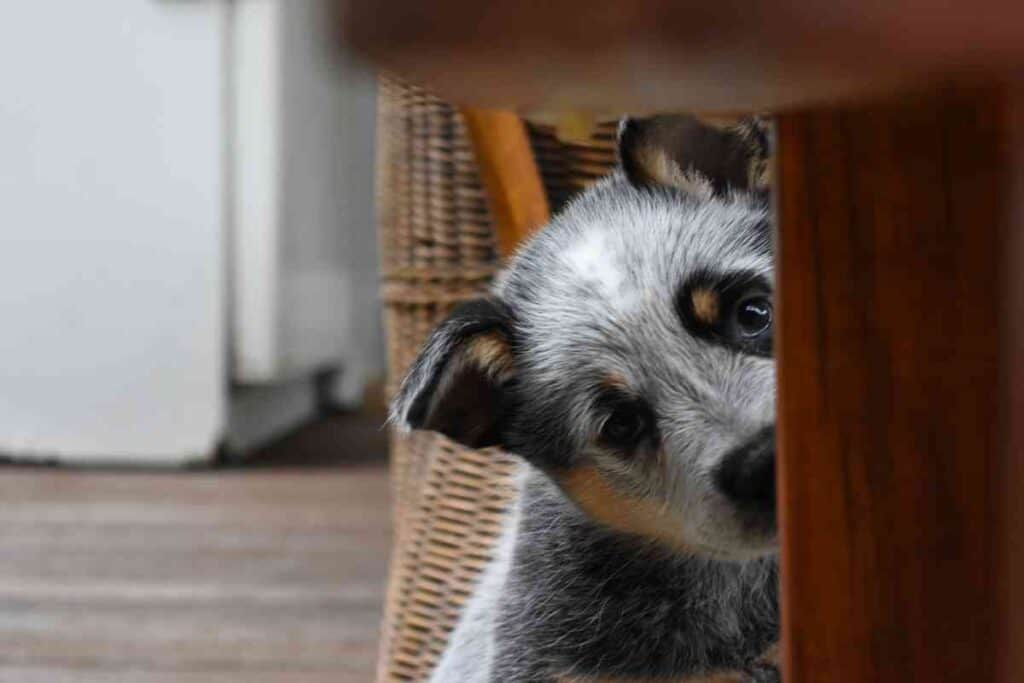Do Blue Heelers Change Colors? (Answer might surprise you)

Have you ever heard that Blue Heelers change colors and wondered if that is true?
Well, if you have this article is for you. We will answer those questions and a few others regarding the coloring of a Blue Heeler.
Do Blue Heelers Change Colors?
Blue Heelers change colors from white at birth to various shades of blue, developing a unique coat with black on their head and tan on their legs. Some may have a black patch over one or both eyes. Coat colors become more defined by six to seven weeks, and the adult coat may have a different shade than their puppy coat.
Wondering whether your pup will develop a darker shade or if your red speckled dog will get more speckled? Here’s what you need to know about Blue Heeler color changes.
Why is the Blue Heeler’s coat so unique?
The Blue Heeler, also knowns as the Australian Cattle Dog or Bluey, is a popular herding dog breed known for its intelligence and energy. The coat is unique because they are descended from the dingo.
These dogs have a unique coat that undergoes changes throughout their lives. As puppies, their coat is soft and dense, and as they grow older, their undercoat becomes thicker to protect them from harsh weather conditions.
The outer coat is typically red speckled or blue speckled with white markings, and the ticking genes give them a speckled appearance. The coat color and pattern can vary, but the red speckled coat is the most common.
The Australian National Kennel Council recognizes lots of colors. Bentley Mark, the oldest dog of this breed, lived to be 29 years old. This breed’s longevity may well come from its wild dog ancestors.
How do Blue Heelers Change Their Coats?
Blue Heelers do change colors from white at birth to different shades of blue which begins around four weeks of age. They will also gradually develop their own unique fur coat with tan on their legs, and black on their head area.
When they begin to shed their puppy coat in favor of the upcoming adult coat, it is not unheard of for their adult coat to have a different shade of blue than their puppy coat did.
Whatever color they eventually turn into, the Blue and Red can have two distinct coat types, the speckled and the mottled, which can add to their uniqueness as adult dogs.
Blue Heelers do change colors from white at birth to different shades of blue which begins around four weeks of age. They will also gradually develop their own unique fur coat with tan on their legs, and black on their head area.
Some Blue Heelers will have a single or double black colored patch over one or both eyes that can be thought of as a mask. Their coloring will be more defined by six or seven weeks of age.
When they begin to shed their puppy coat in favor of the upcoming adult coat, it is not unheard of for their adult coat to have a different shade of blue than their puppy coat did.
Whatever color they eventually turn into, the Blue and Red can have two distinct coat types, the speckled and the mottled, which can add to their uniqueness as adult dogs.
Australian Cattle Dogs which is another name for the Blue Heeler comes in two distinct colors, Blue and Red. Their fur coats start out white and change at four weeks old.
When they begin to shed their puppy coat at around twelve weeks or older, it can change again in adulthood. This will completely develop by the time they are around fourteen to twenty-four months old.
What makes this breed blue color unique serves to help them go undetected at night while driving the cattle. This helped so they didn’t startle the cattle and get injured.

What is the difference between the mottled and speckled design of a Blue Heelers fur coat?
The difference between the mottled and speckled design of a Blue Heelers fur coat is the size of the spots. Think of those speckled candy eggs that we find in stores during Easter or spring holiday. The mottled are a series of larger spots, perhaps the size of a penny.
With either pattern, the desired effect is an even placement of speckles or mottled spots. In either case, the coloring of the speckles or mottled fur is white that shines throughout the black fur. This is the base of the Blue Heeler coloring.
If there is white popping through, the coloring of the Blue Heeler will appear more light and greyish-silver blue. The happy intermingling of the two colors, the black and the white, make this dog’s final characteristic blue coloring.
In either speckled or mottled coloring, the tan is usually seen on the legs and their throat area.
Are the show quality Blue Heelers the same in appearance?
Yes, the Blue Heelers that are bred for being show dogs are the same. They have the same characteristic fur traits, like being speckled or mottled. They have a black fur background with white specks popping through.
The only difference in this arena is that the rules are stricter and will not allow for a show-quality dog. What is meant by this is the way the speckles or mottled fur appears.
Just as health problems or behavior issues like an overly hyper Blue Heeler will lose shows at the AKC, the wrong base color or white patches make for dogs the breeder doesn’t want to produce.
In none show quality Blue Heelers to not have evenly dispersed speckles would be okay as it doesn’t affect the dog’s abilities, overall health, safety, or personality.
However, the disbursement for dogs in the show ring shows superior quality and breeding in appearance and physical character.
For instance, the breed standard for the Blue Heeler Australian Cattle Dog is a certain appearance. The coloring should be blue, blue mottled, or speckled with or without black, blue, or tan markings.
The markings should only be on the head and must be evenly dispersed. Black markings on the body are undesirable.
They set the standard for all other dogs of this type, but this doesn’t mean any Blue Heeler that does not show quality is not a quality dog.
When it relates to traits, the less perfect non-show quality Blue Heelers might have more to offer in that department in some cases.
In a nutshell, the show quality is more stringent on their standards and what is acceptable, while those dogs that are not may or may not look the same.

Does the speckled or mottled Blue Heeler cost more?
Both designs of coat are popular and common. Therefore, their pricing will be comparably around the same. Other factors can drive the price for one or the other up or down.
More popular colorings will increase the price for that design and potentially drive the price for the other down.
Other factors like how the design is dispersed throughout the fur coat will affect pricing up or down. Other things will be factors like gender, age, health, personality, and overall breeding, to name a few.
What can also drive the price up or down is the actual color. The deeper blue color is less noticeable outside at night. This can be handy for working outdoors, making these dogs more desirable for specific uses.
It is said that some dogs of this breed have a characteristic star or mark of white hairs on their forehead that can make a big or small mark or star.
This mark or star is called the Bentley Star or Mark. It is believed that dogs that have that marking were descendants of an Australian Cattle Dog owned and bred by Thomas Bentley from Australia. Dogs with this marking may cost more money. If you have a blue dog with some cream on the forehead, this is perhaps a dog to think twice about neutering.

In Conclusion
Changing fur colors happens to quite a few dog breeds. While this process can be surprising to pet parents its normal and lends itself to some excitingly unique fur coats for a dog.
The Blue Heeler goes from white to an eventual blue color, with a few variations. However, their color does change from birth to adulthood. Blue Heelers are one breed of dogs with a lot to offer anyone with work!
Related Articles Just For You!
If you found this article about Blue Heeler color changes useful, I suggest checking out one of these other articles.
- Blue Heelers change colors from white at birth to different shades of blue around four weeks of age.
- They will develop their own unique fur coat with tan on their legs, and black on their head area.
- Some Blue Heelers will have a single or double black colored patch over one or both eyes that can be thought of as a mask.
- Blue and Red Heelers have two distinct coat types, the speckled and the mottled.
- The difference between the mottled and speckled design is the size of the spots, but both have even placement of speckles or mottled spots.
- Blue Heelers bred for being show dogs have stricter rules on how the speckles or mottled fur appears compared to non-show quality Blue Heelers.
- Both designs of coat are common and priced comparably around the same, but more popular colorings will make the price for that design go up.
- The deeper blue color is less noticeable outside at night, which can make these dogs more desirable for specific uses.
- Dogs with the characteristic Bentley Star or Mark on their forehead may cost more money.
- Changing fur colors is a normal process in many dog breeds.


